Your Brain Explained
The human brain is the most mysterious – and complex – entity in the known universe. It’s a computer, a thinking machine, a fatty pink organ, and a vast collection of neurons – but how does it actually work?

The human brain is amazingly complex – in fact, more complex than anything in the known universe. The brain effortlessly consumes power, stores memories, processes thoughts, and reacts to danger. In some ways, the human brain is like a car engine. The fuel – which could be the sandwich you had for lunch or a sugar doughnut for breakfast – causes neurons to fire in a logical sequence and to bond with other neurons. This combination of neurons occurs incredibly fast, but the chain reaction might help you compose a symphony or recall entire passages of a book, help you pedal a bike or write an email to a friend.
Scientists are just beginning to understand how these brain neurons work – they have not figured out how they trigger a reaction when you touch a hot stove, for example, or why you can regenerate brain cells when you work out at the gym. The connections inside a brain are very similar to the internet – the connections are constantly exchanging information. Yet, even the internet is rather simplistic when compared to neurons. There are ten to 100 neurons, and each one makes thousands of connections. This is how the brain processes information or determines how to move an arm and grip a surface. These calculations, perceptions, memories, and reactions occur almost instantaneously, and not just a few times per minute, but millions. According to Jim Olds, research director with George Mason University, if the internet were as complex as our solar system, then the brain would be as complex as our galaxy. In other words, we have a lot to learn. Science has not given up trying and has made recent discoveries about how we adapt, learn new information, and can actually increase brain capability. In the most basic sense, our brain is the centre of all input and outputs in the human body. Dr Paula Tallal, a co-director of neuroscience at Rutgers University, says the brain is constantly processing sensory information – even from infancy. “It’s easiest to think of the brain in terms of inputs and outputs,” says Tallal. “Inputs are sensory information, outputs are how our brain organises that information and controls our motor systems,” Tallal says one of the primary functions of the brain is in learning to predict what comes next. In her research for Scientific Learning, she has found that young children enjoy having the same book read to them again and again because that is how the brain registers acoustic cues that form into phonemes (sounds to become spoken words. “We learn to put things together so that they become smooth sequences,” she says. These smooth sequences are observable in the brain, interpreting the outside world and making sense of it. The brain is actually a series of interconnected ‘superhighways’ or pathways that move ‘data’ from one part of the body to another. Tallal says another way to think about the brain is by lower and upper areas. The spinal cord moves information up to the brain stem, then up into the cerebral cortex which controls thoughts and memories. Interestingly, the brain really does work like a powerful computer in determining not only movements but registering memories that can be quickly recalled. According to Dr Robert Melillo, a neurologist and the founder of the Brain Balance Centers (www.brainbalancecenters.com), says the brain actually predetermines actions and calculates the results about a half-second before performing them (or even faster in some cases). This means, when you reach out to open a door, your brain has already predetermined how to move your elbow and clasp your hand – maybe even simulated this movement more than once before you even perform the action. Another interesting aspect of the brain is that there are some voluntary movements and some involuntary. Some sections of the brain might control a voluntary movement – such as patting your knee to a beat. Another section controls involuntary movements, such as the gait of your walk – which is passed down from your parents. Reflexes, long-term memories, the pain reflex they are all controlled by sections in the brain.
Neurons Explained
Neurons fire like electrical circuits.

Neurons are a kind of cell in the brain (humans have many cells in the body, including fat cells, kidney cells, and gland cells). A neuron is essentially like a hub that works with nearby neurons to generate an electrical and chemical charge. Dr Likosky of the Swedish Medical Institute says another way of thinking about neurons is that they are like a basketball and the connections (called axons) are like electrical wires that connect to other neurons. This creates a kind of circuit in the human body. Tallal explained that input from the five senses in the body cause neurons to fire. “The more often a collection of neurons are stimulated together in time, the more likely they are to bind together and the easier and easier it becomes for that pattern of neurons to fire in synchrony as well as sequentially,” says Tallal.
What Does The Spinal Chord Do?
The spinal cord actually is part of the brain and plays a major role in your body.
Scientists have known for the past 100 years or so that the spinal cord is actually part of the brain. According to Melillo, while the brain has the grey matter on the outside (protected by the skull) and protected white matter on the inside, the spinal cord is the reverse: the grey matter is inside the spinal cord and the white matter is outside.
This article was originally published in How It Works issue 99
For more science and technology articles, pick up the latest copy of How It Works from all good retailers or from our website now. If you have a tablet or smartphone, you can also download the digital version onto your iOS or Android device. To make sure you never miss an issue of How It Works magazine, subscribe today!




